Abstract
1 The actions and interactions of adenosine and dipyridamole were investigated on isolated strips of coronary arteries of beef cattle. It was found that small diameter arteries (about 0.5-1.0 mm o9d.), raised to a moderate level of tone with potassium, responded with relaxation to low concentrations of adenosine. 2 Dipyridamole, over a broad concentration range (6.0 X 10(-8)-2.0 X 10(-5)M), enhanced these responses, shifting the adenosine concentration-response curve (3.7 X 10(-8)-1.1 X 10(-4)M) considerably to the left. In contrast, inhibitory concentrations-response curves to sodium nitrite and to noradrenaline were not materially altered by dipyridamole. 3 Studies of the uptake of [3H]-adenosine revealed a rapid uptake of the nucleoside by coronary artery strips, which was inhibited by dipyridamole (6.0X 10(-8)-2.0X10(-5)M); but this may not be sufficient to account fully for the observed sensitization. 4 It is concluded that the regulation of adenosine responses and the action of dipyridamole in the heart involve a more direct association with coronary vascular tissue than has been previously appreciated.
Full text
PDF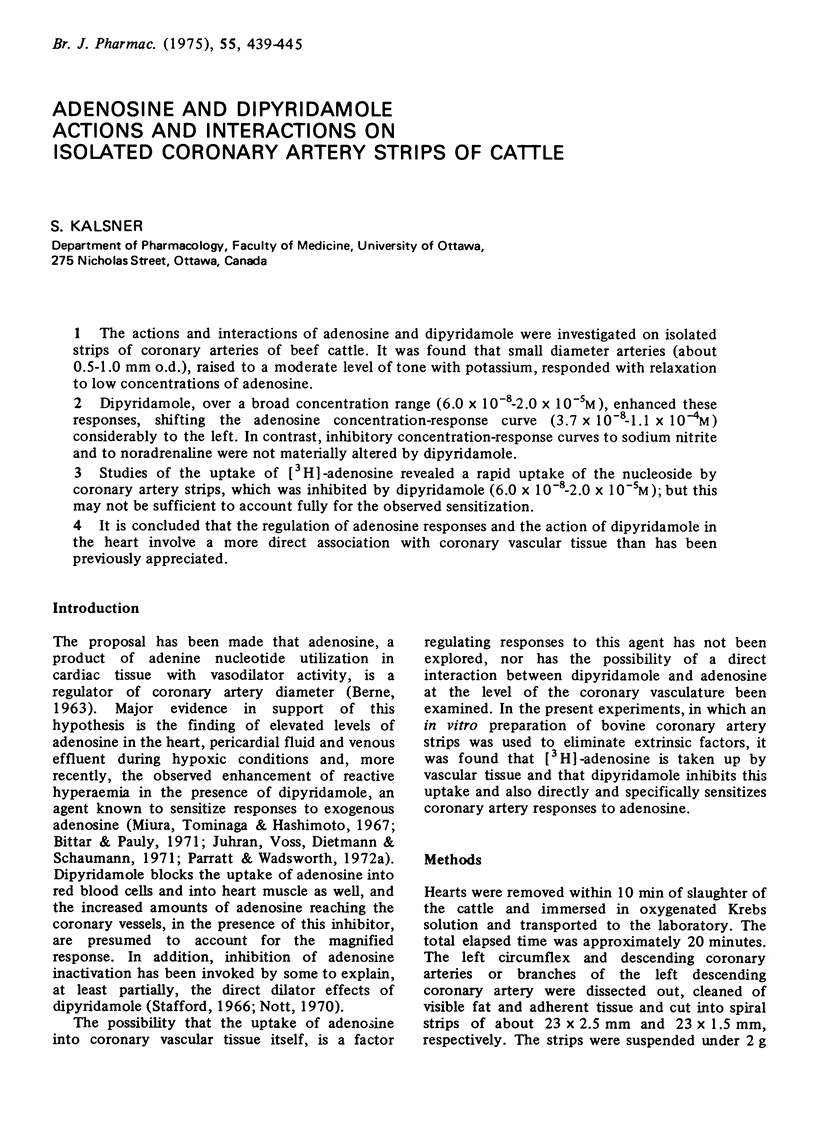
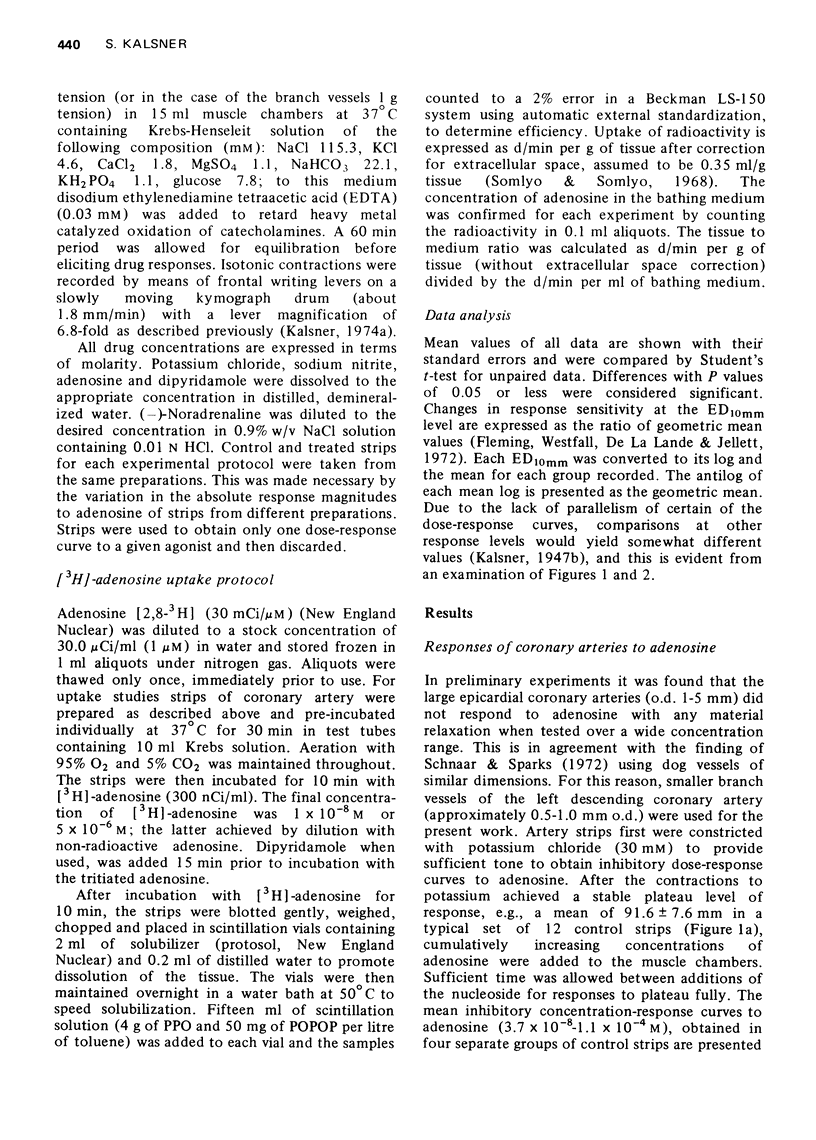
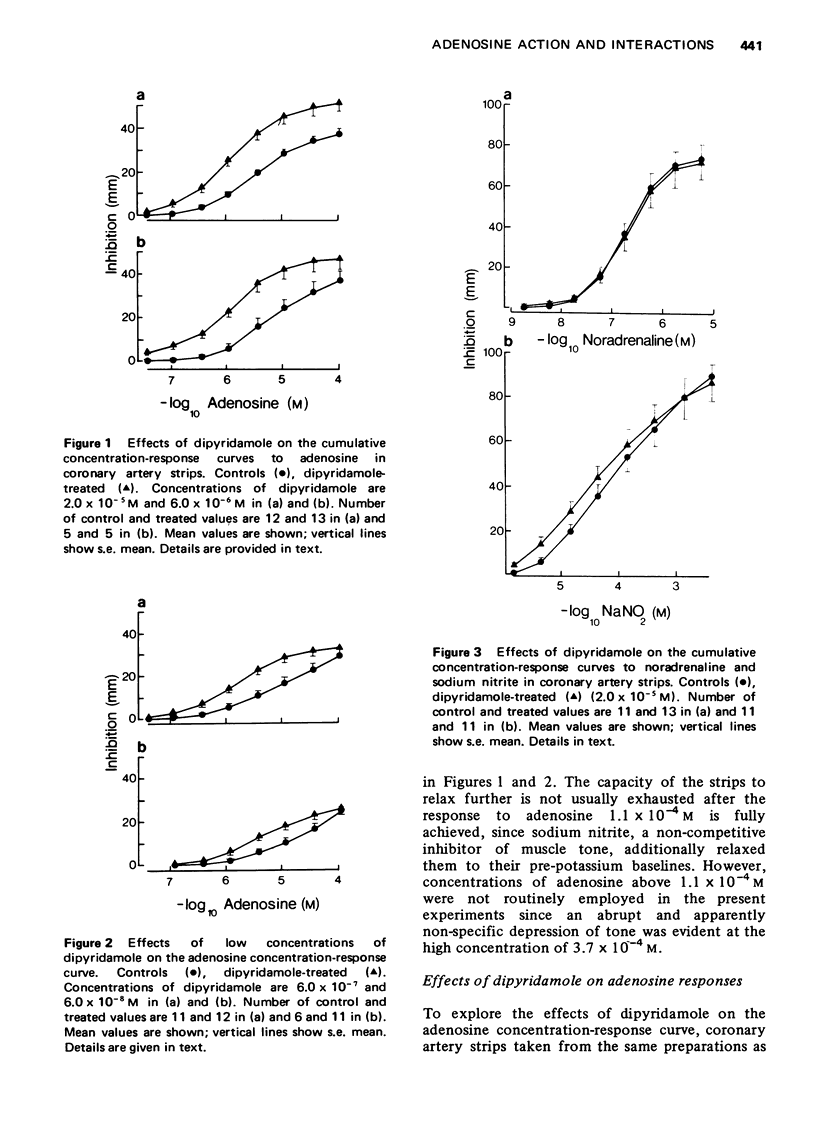
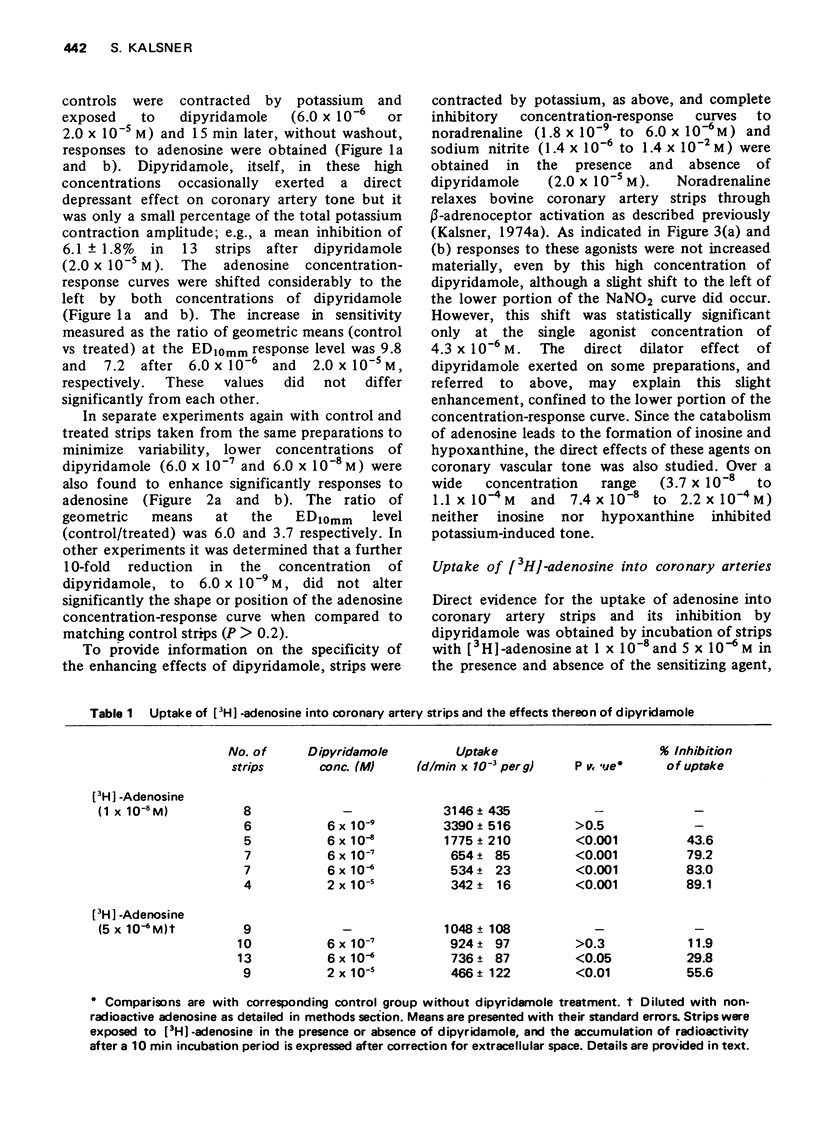

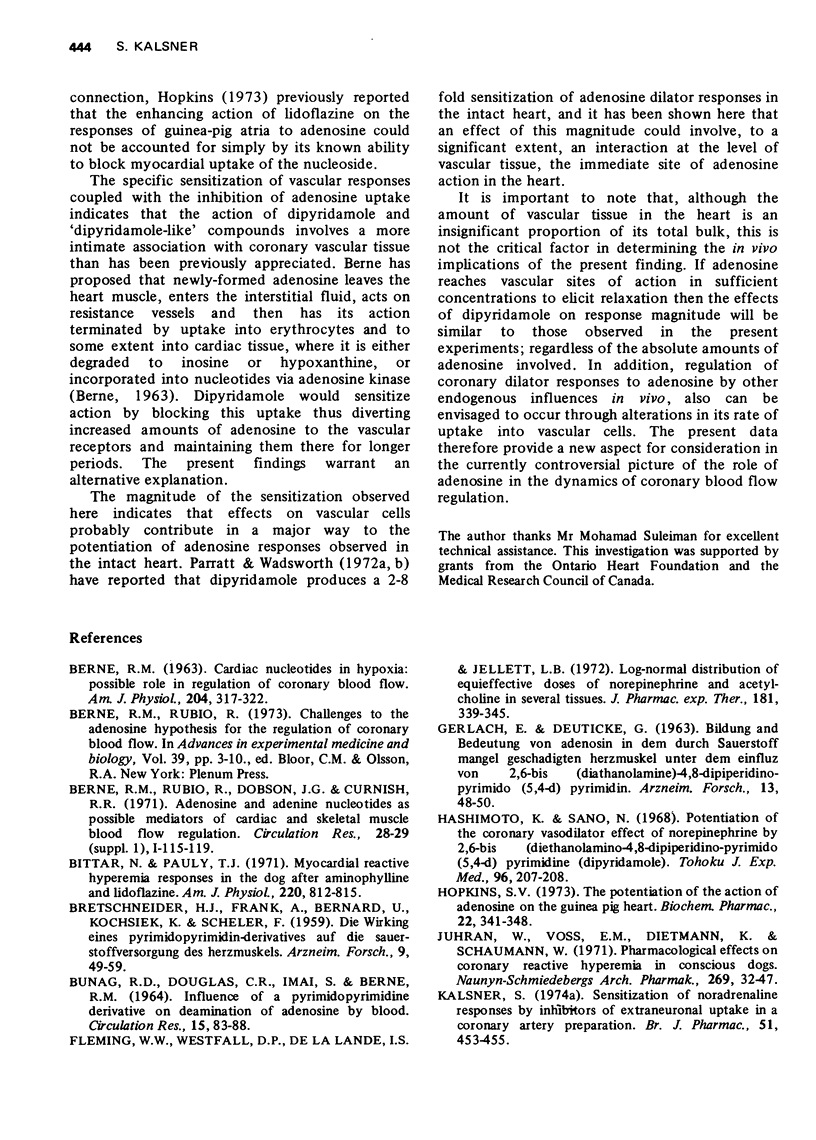
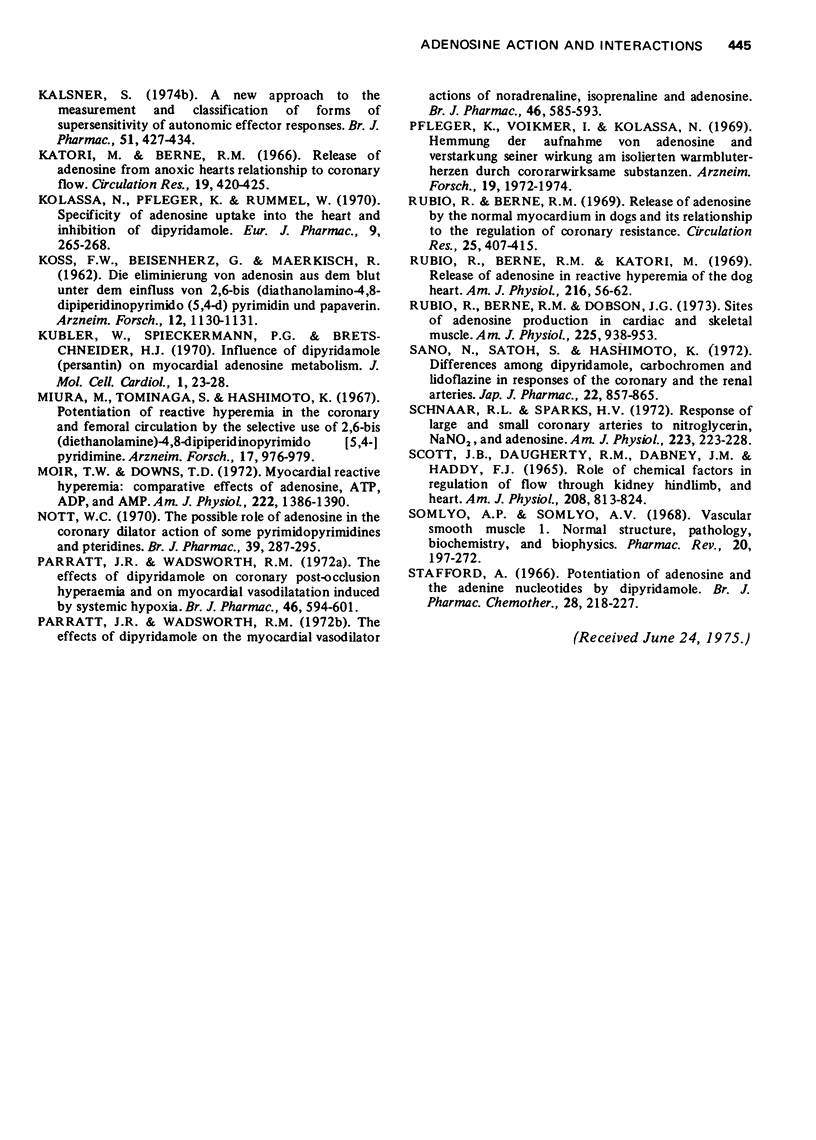
Selected References
These references are in PubMed. This may not be the complete list of references from this article.
- BERNE R. M. Cardiac nucleotides in hypoxia: possible role in regulation of coronary blood flow. Am J Physiol. 1963 Feb;204:317–322. doi: 10.1152/ajplegacy.1963.204.2.317. [DOI] [PubMed] [Google Scholar]
- BRETSCHNEIDER H. J., FRANK A., BERNARD U., KOCHSIEK K., SCHELER F. Die Wirkung eines Pyrimidopyrimidin-Derivates auf die Sauerstoffversorgung des Herzmuskels. Arzneimittelforschung. 1959 Jan;9(1):49–59. [PubMed] [Google Scholar]
- BUNAG R. D., DOUGLAS C. R., IMAI S., BERNE R. M. INFLUENCE OF A PYRIMIDOPYRIMIDINE DERIVATIVE ON DEAMINATION OF ADENOSINE BY BLOOD. Circ Res. 1964 Jul;15:83–88. doi: 10.1161/01.res.15.1.83. [DOI] [PubMed] [Google Scholar]
- Berne R. M., Rubio R., Dobson J. G., Jr, Curnish R. R. Adenosine and adenine nucleotides as possible mediators of cardiac and skeletal muscle blood flow regulation. Circ Res. 1971 Jan;28(Suppl):115+–115+. [PubMed] [Google Scholar]
- Bittar N., Pauly T. J. Myocardial reactive hyperemia responses in the dog after aminophylline and lidoflazine. Am J Physiol. 1971 Mar;220(3):812–815. doi: 10.1152/ajplegacy.1971.220.3.812. [DOI] [PubMed] [Google Scholar]
- Fleming W. W., Westfall D. P., De la Lande I. S., Jellett L. B. Log-normal distribution of equiefective doses of norepinephrine and acetylcholine in several tissues. J Pharmacol Exp Ther. 1972 May;181(2):339–345. [PubMed] [Google Scholar]
- Hashimoto K., Sano N. Potentiation of the coronary vasodilator effect of norepinephrine by 2,6-bis (diethanolamino)-4,8-dipiperidino-pyrimido (5,4-d) pyrimidine (dipyridamole). Tohoku J Exp Med. 1968 Oct;96(2):207–208. doi: 10.1620/tjem.96.207. [DOI] [PubMed] [Google Scholar]
- Hopkins S. V. The potentiation of the action of adenosine on the guinea-pig heart. Biochem Pharmacol. 1973 Feb 1;22(3):341–348. doi: 10.1016/0006-2952(73)90415-2. [DOI] [PubMed] [Google Scholar]
- KOSS F. W., BEISENHERZ G., MAERKISCH R. [The elimination of adenosine from the blood under the influence of 2,6-bis(diethanolamino)-4,8-dipiperidinopyrimido-(5,4-d) pyrimidine and papaverine]. Arzneimittelforschung. 1962 Nov;12:1130–1131. [PubMed] [Google Scholar]
- Kalsner S. A new approach to the measurement and classification of forms of supersensitivity of autonomic effector responses. Br J Pharmacol. 1974 Jul;51(3):427–434. doi: 10.1111/j.1476-5381.1974.tb10678.x. [DOI] [PMC free article] [PubMed] [Google Scholar]
- Kalsner S. Sensitization of noradrenaline responses by inhibitors of extraneuronal uptake in a coronary artery preparation. Br J Pharmacol. 1974 Jul;51(3):453–455. doi: 10.1111/j.1476-5381.1974.tb10682.x. [DOI] [PMC free article] [PubMed] [Google Scholar]
- Katori M., Berne R. M. Release of adenosine from anoxic hearts. Relationship to coronary flow. Circ Res. 1966 Aug;19(2):420–425. doi: 10.1161/01.res.19.2.420. [DOI] [PubMed] [Google Scholar]
- Kolassa N., Pfleger K., Rummel W. Specificity of adenosine uptake into the heart and inhibition by dipyridamole. Eur J Pharmacol. 1970 Mar;9(3):265–268. doi: 10.1016/0014-2999(70)90221-9. [DOI] [PubMed] [Google Scholar]
- Kübler W., Spieckermann P. G., Bretschneider H. J. Influence of dipyridamol (Persantin) on myocardial adenosine metabolism. J Mol Cell Cardiol. 1970 Mar;1(1):23–38. doi: 10.1016/0022-2828(70)90026-x. [DOI] [PubMed] [Google Scholar]
- Miura M., Tominaga S., Hashimoto K. Potentiation of reactive hyperemia in the coronary and femoral circulation by the selective use of 2,6-bis(diethanolamino)-4,8-dipiperidino-pyrimodo[5,4-d]pyrimidine. Arzneimittelforschung. 1967 Aug;17(8):976–979. [PubMed] [Google Scholar]
- Moir T. W., Downs T. D. Myocardial reactive hyperemia: comparative effects of adenosine, ATP, ADP, and AMP. Am J Physiol. 1972 Jun;222(6):1386–1390. doi: 10.1152/ajplegacy.1972.222.6.1386. [DOI] [PubMed] [Google Scholar]
- Nott M. W. The possible role of adenosine in the coronary dilator action of some pyrimidopyrimidines and pteridines. Br J Pharmacol. 1970 Jun;39(2):287–295. doi: 10.1111/j.1476-5381.1970.tb12892.x. [DOI] [PMC free article] [PubMed] [Google Scholar]
- Parratt J. R., Wadsworth R. M. The effects of dipyridamole on coronary post-occlusion hyperaemia and on myocardial vasodilatation induced by systemic hypoxia. Br J Pharmacol. 1972 Dec;46(4):594–601. doi: 10.1111/j.1476-5381.1972.tb06886.x. [DOI] [PMC free article] [PubMed] [Google Scholar]
- Parratt J. R., Wadsworth R. M. The effects of dipyridamole on the myocardial vasodilator actions of noradrenaline, isoprenaline and adenosine. Br J Pharmacol. 1972 Dec;46(4):585–593. doi: 10.1111/j.1476-5381.1972.tb06885.x. [DOI] [PMC free article] [PubMed] [Google Scholar]
- Pfleger K., Volkmer I., Kolassa N. Hemmung der Aufnahme von Adenosin und Verstärkung seiner Wirkung am isolierten Warmblüterherzen durch coronarwirksame Substanzen. Arzneimittelforschung. 1969 Dec;19(12):1972–1974. [PubMed] [Google Scholar]
- Rubio R., Berne R. M., Katori M. Release of adenosine in reactive hyperemia of the dog heart. Am J Physiol. 1969 Jan;216(1):56–62. doi: 10.1152/ajplegacy.1969.216.1.56. [DOI] [PubMed] [Google Scholar]
- Rubio R., Berne R. M. Release of adenosine by the normal myocardium in dogs and its relationship to the regulation of coronary resistance. Circ Res. 1969 Oct;25(4):407–415. doi: 10.1161/01.res.25.4.407. [DOI] [PubMed] [Google Scholar]
- SCOTT J. B., DAUGHERTY R. M., Jr, DABNEY J. M., HADDY F. J. ROLE OF CHEMICAL FACTORS IN REGULATION OF FLOW THROUGH KIDNEY, HINDLIMB, AND HEART. Am J Physiol. 1965 May;208:813–824. doi: 10.1152/ajplegacy.1965.208.5.813. [DOI] [PubMed] [Google Scholar]
- Sano N., Sato S., Hashimoto K. Differences among dipyridamole, carbochromen and lidoflazine in responses of the coronary and the renal arteries. Jpn J Pharmacol. 1972 Dec;22(6):857–865. doi: 10.1254/jjp.22.857. [DOI] [PubMed] [Google Scholar]
- Schnaar R. L., Sparks H. V. Response of large and small coronary arteries to nitroglycerin, NaNO 2 , and adenosine. Am J Physiol. 1972 Jul;223(1):223–228. doi: 10.1152/ajplegacy.1972.223.1.223. [DOI] [PubMed] [Google Scholar]
- Somlyo A. P., Somlyo A. V. Vascular smooth muscle. I. Normal structure, pathology, biochemistry, and biophysics. Pharmacol Rev. 1968 Dec;20(4):197–272. [PubMed] [Google Scholar]
- Stafford A. Potentiation of adenosine and the adenine nucleotides by dipyridamole. Br J Pharmacol Chemother. 1966 Nov;28(2):218–227. doi: 10.1111/j.1476-5381.1966.tb01888.x. [DOI] [PMC free article] [PubMed] [Google Scholar]


